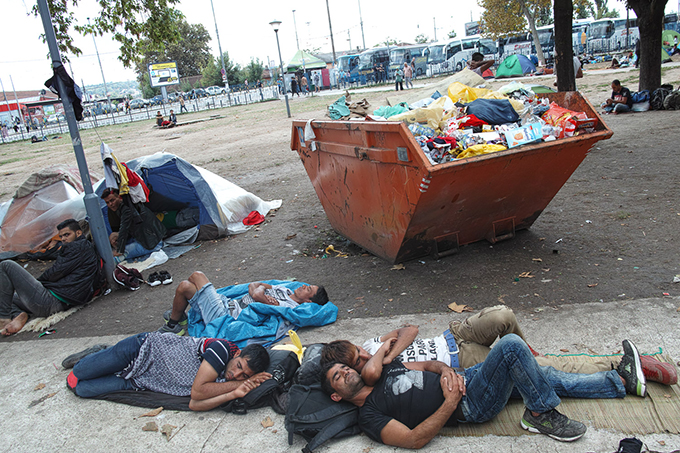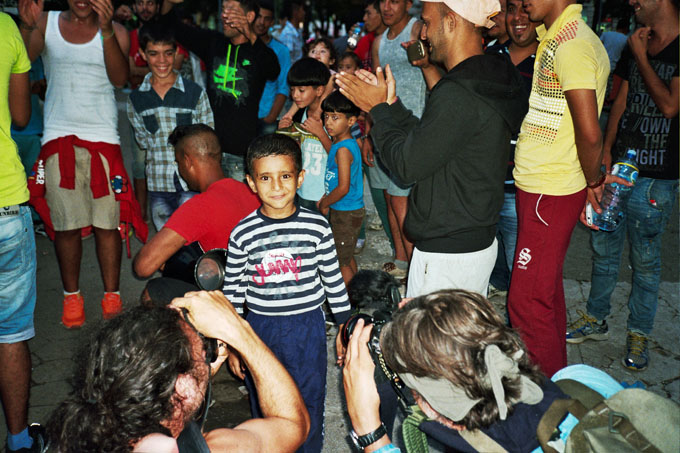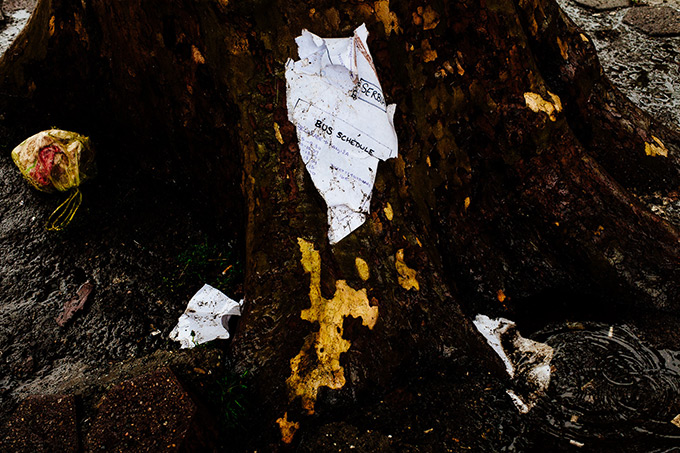
Morning in one of the Belgrade parks where the refugees rest before continuing their trip to Europe. September 2015. Author Jelena Mijič (Belgrade Raw).
There are two parks facing Belgrade’s main bus station. Over the past few months they have become a temporary home for thousands of refugees hailing primarily from the Middle East, Afghanistan and Africa. Serbia is considered a stopover before entering the Schengen Area (a collection of 26 European countries that one is free to travel in and out of once inside) as it abuts Hungary, a member of the European Union. Within a journey typically pockmarked with danger, Belgrade is seen as a kind of safe resting stop before the final—and often more difficult—leg of the trip.
It wasn’t always this way. Not long ago police in Belgrade were forcibly removing people from the parks, telling them to go “anywhere but here.” Partly in reaction to citizens who protested, and also because of the sharp influx of refugees this summer, the police position was reversed. The refugees are now somewhat “welcome” to stay in the park. Public officials, including the prime minister and mayor, have even issued statements detailing how pleased they are with Serbia’s position of being helpful to refugees.
In reality, the park is the only thing on offer, as moving into a hotel or hostel is illegal if one doesn’t have the proper police-issued permit, which is often impossible to obtain due to the backlog of requests. Only now, after several months of virtually no services at either park, a few mobile toilets and a water truck have been installed at one of them.
The areas surrounding the parks are quickly adapting to the refugees’ needs. Fast-food restaurants and currency-exchange bureaus now have Arabic and Pashto signs in their windows. On the edges of the parks, arrangements are made to find transport to other cities in Serbia and Hungary.
Ordinary citizens have stepped in to help with basic necessities like food and medication, and they have also offered vital on-the-ground information to the refugees. With a couple of exceptions, they have provided these services more swiftly than many of the indecisive and cumbersome humanitarian organizations here. Despite all the aforementioned assistance, those in the park most seriously depend on warm weather—cold nights and rainy days are hard to manage. And now winter is just around the corner.

A man sleeps on the ground in the park across from the main bus station. The mayor of Belgrade and government officials proudly claim that they are doing their best to create decent conditions for migrants so they can feel at least a little bit of dignity, but the truth is that many refugees cannot even find a place to spend night indoors so they must sleep in the parks on the bare ground. September 2015. Author Jelena Mijić (Belgrade Raw).

A vacant tent in the park next to the bus station, where hundreds of refugees, are staying. But after a day of heavy rain, most of the tents are vacated. September 2015. Author Luka Knežević Strika (Belgrade Raw).

Eight a.m. in the park which is the sleeping place for most of the refugees who arrive to Belgrade. Most of the people are already awake but this group of young men still sleeps despite the traffic noise and morning chill. September 2015. Author Jelena Mijić (Belgrade Raw).

A migrant boy around six years old being photographed by photojournalists during the solidarity action, when the group No Borders makes tea for the refugees in the park. These actions happen every Saturday afternoon, and often they turn the park to a small party with traditional Syrian music and dancing. September 2015. Author Jelena Mijič (Belgrade Raw)

Remnants of a map someone drew in the park to help migrants navigate to the border in Hungary, destroyed by heavy rain. September 2015. Author Luka Knežević Strika (Belgrade Raw).

A group of migrants, under the bridge in Belgrade’s Savamala district. The bridge provides shelter from the rain and shade from the strong midsummer sun. The area has since been closed off as a construction site, part of the often disputed “Belgrade Waterfront” project. July 2015. Author Luka Knežević Strika (Belgrade Raw).

A group of refugees under the bridge in Belgrade’s Savamala district. They use the river to wash themselves and their clothes. The area has since then been closed off as a construction site, part of the often disputed “Belgrade Waterfront” project. July 2015. Author Luka Knežević Strika (Belgrade Raw).

Many citizens of Belgrade are trying to help refugees by bringing some items like food or sweets for children, or bags of secondhand clothes. Unfortunately this process is haphazard because there is little information about what things are most needed, so some donated items, like this pair of women’s jeans, ends up discarded. September 2015. Author Jelena Mijić (Belgrade Raw).
This piece was made possible, in part, thanks to the generous support of the Trust for Mutual Understanding.

